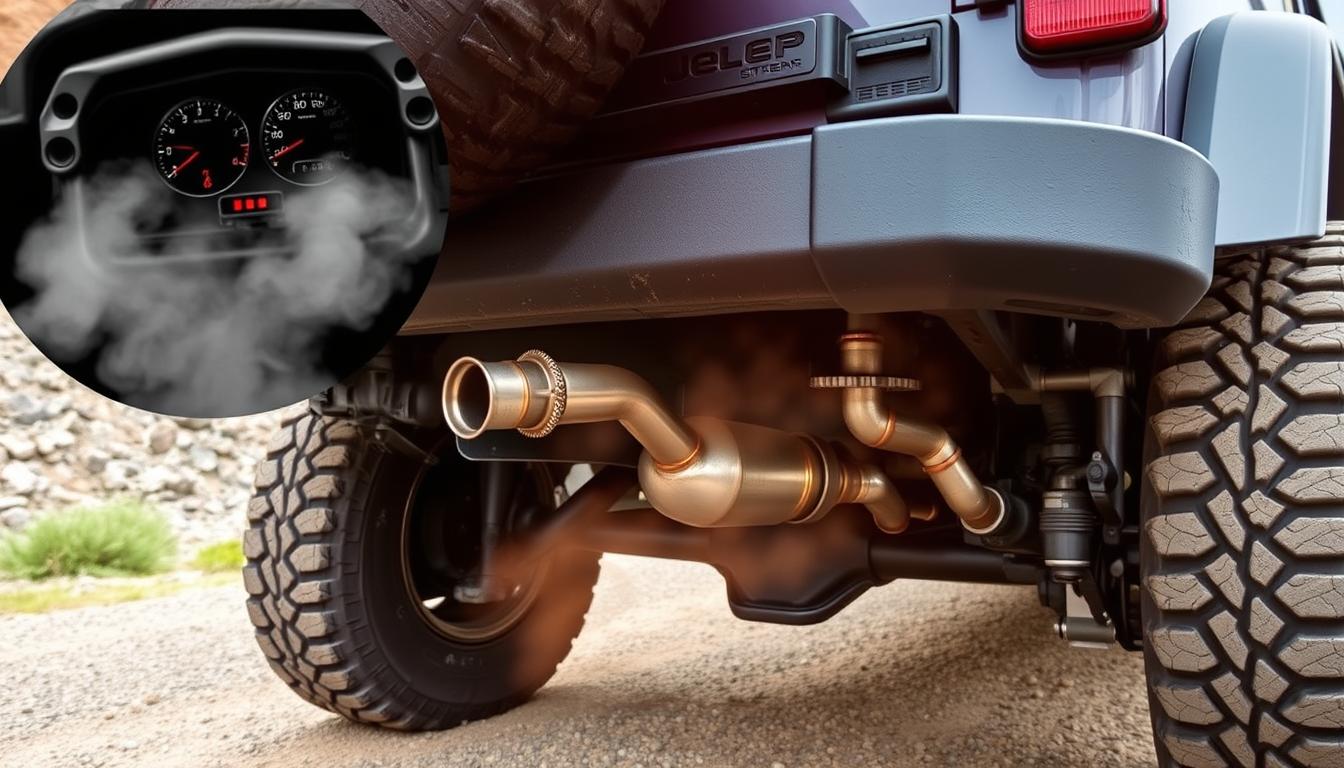A bad catalytic converter in your Jeep Wrangler can cause big problems. In 34 U.S. states, failing emissions tests because of this issue can stop you from registering your vehicle. These problems often start small but can get worse fast, affecting how well your car runs and how much fuel it uses.
The check engine light is a common warning sign. It might turn on because of issues with oxygen or air/fuel sensors. You might also smell something like sulfur, hear rattling noises, or feel a sudden drop in power. If you ignore these signs, you could face expensive repairs and even damage to your engine. Catching these problems early can help avoid big fines and keep your car running right.
Key Takeaways
- 34 states require emissions testing, where catalytic converter failures commonly cause rejection.
- Check engine warnings often link to catalytic converter errors in modern Jeep Wranglers.
- Clogged converters operate at extreme temperatures, reducing fuel efficiency by up to 30%.
- Acceleration loss or engine misfires indicate restricted exhaust flow or incomplete combustion.
- Rotten egg odors or rattling sounds suggest internal damage requiring immediate inspection.
Understanding Your Jeep Wrangler’s Catalytic Converter
The catalytic converter in your Jeep Wrangler is key to reducing harmful emissions. It changes exhaust gases like carbon monoxide and nitrogen oxides into safer substances. A honeycomb structure coated with precious metals inside acts as a catalyst, speeding up these changes.
Modern three-way converters, introduced in 1981, handle multiple pollutants at once. This ensures your Wrangler meets strict environmental standards.
Function and Purpose
Your Wrangler’s catalytic converter cuts up to 90% of harmful emissions. The honeycomb design increases surface area, making reactions more efficient. This is thanks to platinum, palladium, and rhodium.
Spotting signs of a failing catalytic converter early can save you money. For example, code P0420 often means the converter is not working well due to wear or damage.
Location in the Exhaust System
The catalytic converter sits between the engine and muffler. It’s part of the exhaust pipeline. Depending on the engine, your Wrangler might have more than one converter.
Damage from off-road debris or rust can harm its position. This can restrict airflow and affect performance.
Common Causes of Failure
Catalytic converter failure often comes from:
- Clogging: Melted honeycomb structures from overheating or unburned fuel.
- Engine misfires: Excess fuel entering the exhaust, damaging the catalyst.
- External damage: Impacts from rocks or debris during off-road use.
- Sensor failures: Faulty oxygen sensors disrupting air-fuel ratios.
| Cause | Impact | Solution |
|---|---|---|
| Overheating | Melts internal components | Repair engine misfires promptly |
| Oil/Coolant Contamination | Blocks catalytic pathways | Fix leaks before replacing converter |
| Age/Mileage | Natural wear after 150,000 miles | Opt for OEM-quality jeep wrangler catalytic converter replacement |
Federal warranties cover defective converters for up to 15 years or 150,000 miles. Regular maintenance, like fixing check engine lights quickly, helps it last longer. If you notice black smoke or sulfur smells, get it checked to avoid damage.
Common Jeep Wrangler Bad Catalytic Converter Symptoms
A failing catalytic converter in your Jeep Wrangler can cause noticeable problems. Spotting these signs early can save you from expensive fixes and keep your exhaust system running smoothly. Here are the most common symptoms of a bad catalytic converter:
- Check Engine Light Activation: The jeep wrangler check engine light catalytic converter warning is a key sign. Faulty converters often show error codes like P0420 or P0430, which mean they’re not working right.
- Sluggish Acceleration: If your engine feels weak, it might be because of a clogged converter. This is more noticeable when driving uphill or towing.
- Unusual Exhaust Smells: A smell like rotten eggs means sulfur buildup. Sweet or metallic smells suggest coolant or oil getting into the system.
- Fuel Efficiency Drop: A bad converter can mess up the air-fuel mix. This leads to using more fuel than usual.
“Ignoring catalytic converter symptoms risks damaging the entire jeep wrangler exhaust system. Clogs force the engine to work harder, accelerating wear on oxygen sensors and exhaust components.”
Rattling sounds under the car often mean a broken catalyst substrate. These sounds, along with rough idling or misfires, show exhaust flow problems. Fixing these issues early prevents more damage and keeps your vehicle emissions-compliant.
If the check engine light comes on with these symptoms, use an OBD-II scanner to get error codes. If you keep getting warnings, it’s time for a pro to check if the catalytic converter is bad and plan the fix.
Engine Performance Issues and Power Loss
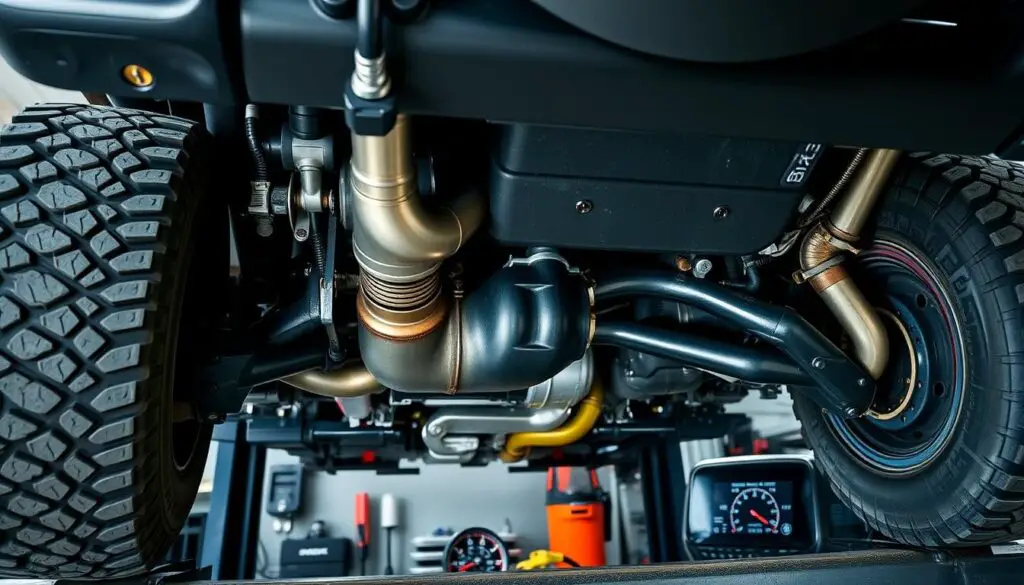
A failing catalytic converter hurts your Jeep Wrangler’s engine. It makes the engine work harder because of blocked exhaust flow. This leads to less power.
About 30% of drivers notice their Jeep doesn’t accelerate well because of the converter. Also, 75% of cars with emission problems have less power.
Reduced Acceleration
Having trouble speeding up or passing other cars? A clogged converter limits exhaust flow. This means the engine gets less oxygen, making it run lean. This cuts down horsepower.
Some drivers have tried drilling holes in the exhaust pipe to fix this. But, this is only a temporary solution.
Engine Misfires
Unburned fuel can damage the converter by igniting inside. This causes the engine to misfire. If not fixed, it can overheat, risking engine failure.
Catalytic converters work at 800°F. Blockages can raise the temperature, causing serious damage.
Rough Idling Problems
A bad converter messes with air-fuel balance, causing the engine to shake or stall. This also makes the car use more fuel. Fixing it early can save you from expensive repairs.
| Issue | Statistic | Impact |
|---|---|---|
| Fuel Efficiency Loss | Up to 20% | Increased refueling costs |
| Emissions Test Failure | 34 states require functioning converters | Failed inspections |
| Engine Overheating Risk | 75% of vehicles face performance loss | Potential engine damage |
Knowing how to spot a failing catalytic converter is key. Regular checks and maintenance help keep the exhaust flowing right. Ignoring signs can lead to legal trouble and engine damage.
Unusual Exhaust Sounds and Smells
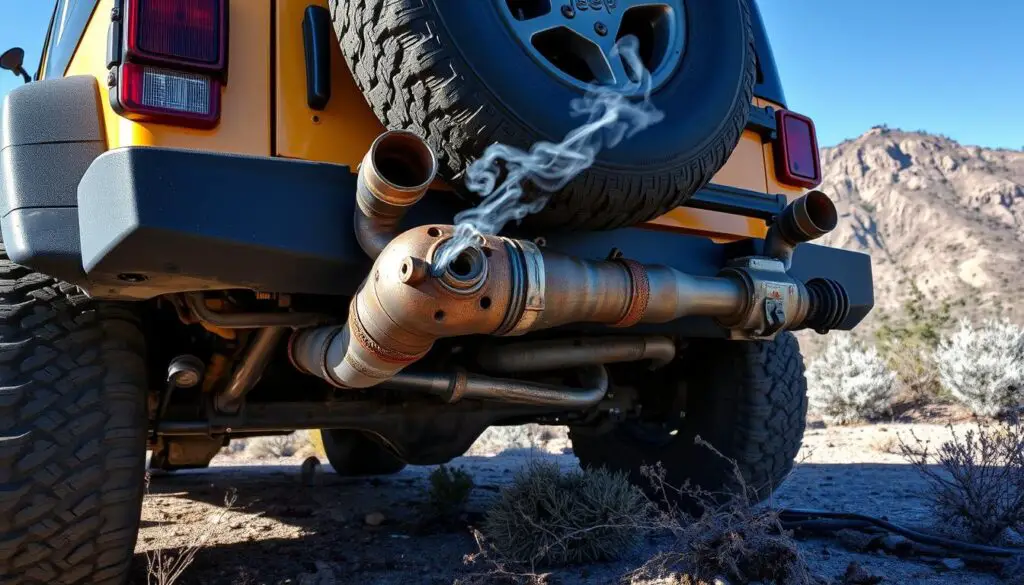
Strange smells or noises from your Jeep Wrangler’s exhaust can mean big problems. A bad catalytic converter or damaged parts can hurt your car’s performance and safety. It can also break emissions laws.
- Rotten egg or sulfur smells: This smell means your catalytic converter is not working right. It might be too hot or dirty from unburned fuel.
- Sweet, syrupy odor: This smell is bad news. It means coolant is leaking into your engine, which can damage it.
- Strong gasoline fumes: This smell is often from a rich air/fuel mix. It could be from clogged air filters, faulty sensors, or leaking fuel injectors. Black smoke from the tailpipe is a sign of this too.
Catalytic converter failure is a big problem, causing 30% of engine complaints. It often happens with misfires or oxygen sensor errors.
Strange noises like rattling or rumbling might mean exhaust leaks or a broken converter. Leaks near the engine can let toxic carbon monoxide into your car. This can make your car smell musty or smoky. It’s very important to check this right away.
Fixing jeep wrangler catalytic converter problems early can save you a lot of money. Mechanics say to look for loose heat shields, damaged pipes, or internal converter damage. Since converters are needed by law in most places, fixing them keeps your car safe and legal.
Check Engine Light Warnings
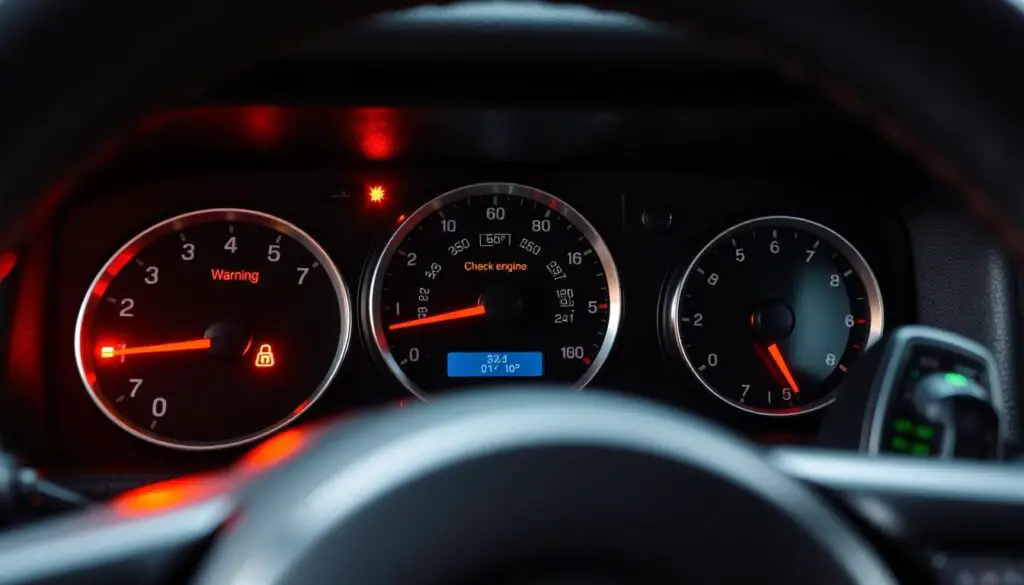
A flashing or steady check engine light in your Jeep Wrangler often signals catalytic converter trouble. Ignoring it risks severe engine damage or costly jeep wrangler catalytic converter replacement. Diagnostic trouble codes (DTCs) stored in the vehicle’s computer pinpoint the issue.
Common Error Codes
Faulty catalytic converters trigger specific codes:
- P0420: Low catalyst efficiency, indicating degraded converter function.
- P0430: Similar to P0420 but for bank 2 in dual-exhaust systems.
- P2096: Post-catalyst fuel trim too lean, suggesting oxygen sensor issues.
A flashing light usually means critical misfires, which can overheat the converter.
Professional diagnosis costs between $88 and $111, but addressing codes early prevents higher repair bills.
Using OBD-II Scanners
Plug an OBD-II scanner into your Jeep’s port under the dashboard to retrieve codes. Clear codes only after fixing the problem—resetting them without repairs masks jeep wrangler bad catalytic converter symptoms. Basic scanners show codes, while advanced tools analyze live sensor data.
Professional Diagnostic Methods
Mechanics use backpressure tests and infrared thermometers to check converter efficiency. Excess exhaust pressure or uneven temperatures confirm failure. Combined with error codes, these tests determine if a jeep wrangler catalytic converter replacement is necessary. Schedule service immediately for flashing lights to avoid unburned fuel damaging the converter.
Impact on Fuel Efficiency and Economy
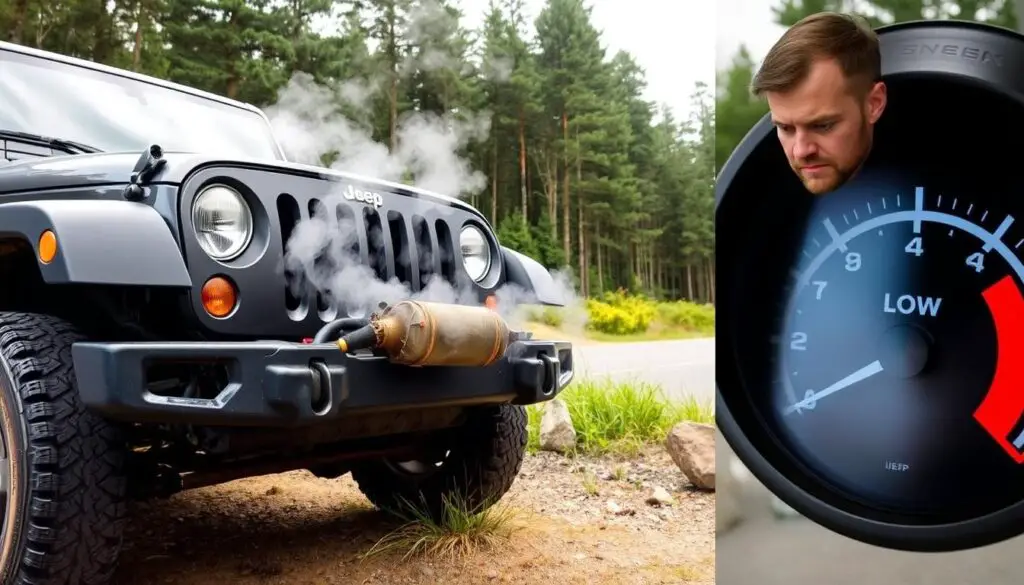
Jeep Wrangler catalytic converter problems often show up as unexpected drops in fuel efficiency. A clogged or damaged converter makes it hard for exhaust to flow. This forces the engine to work harder, leading to more fuel use and more frequent stops at the pump.
Signs of a failing catalytic converter in Jeep Wrangler models include a sudden 20-30% decline in miles per gallon (MPG). Owners may also notice:
- Unusual hesitation during acceleration
- Persistent fuel odor from exhaust
- Dark exhaust smoke indicating incomplete combustion
The table below outlines typical fuel economy changes linked to converter issues:
| Condition | Average MPG (City/Highway) | Warning Signs |
|---|---|---|
| Healthy Converter | 17/23 | Consistent performance |
| Failing Converter | 13/18 | Rough idling, sulfur smells |
Diagnosing these issues early can prevent long-term engine damage. Mechanics suggest checking oxygen sensor data and exhaust backpressure when MPG drops without explanation. Fixing jeep wrangler catalytic converter problems quickly can get fuel economy back to factory levels in just one service visit.
Professional Diagnosis and Testing Methods
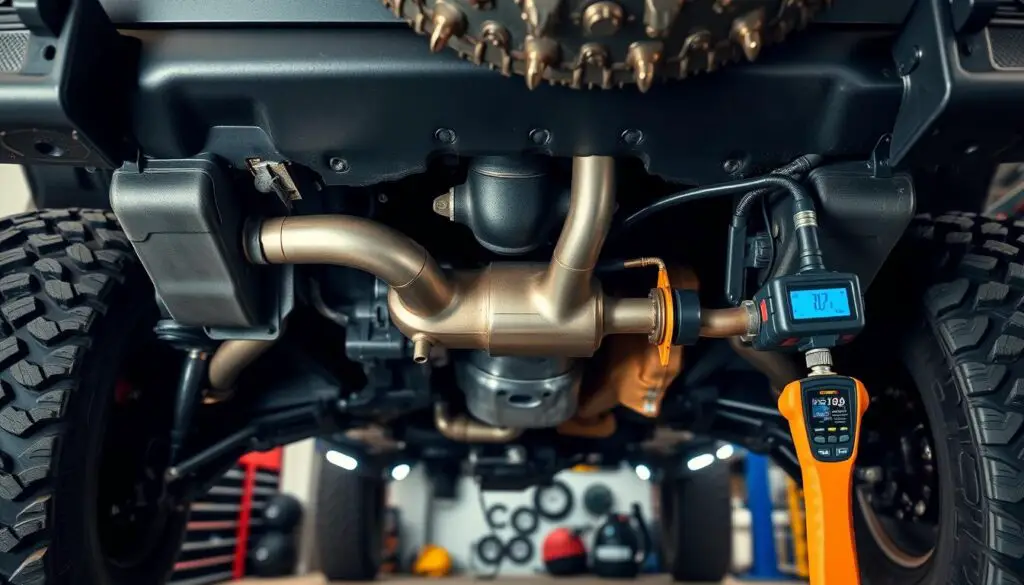
Figuring out catalytic converter problems in a Jeep Wrangler needs special tools and skills. Mechanics use three main ways to find issues: back pressure tests, temperature checks, and looking at the parts themselves. These steps help find problems accurately and keep the emission system working right.
Back Pressure Testing
Too much back pressure in the exhaust can mean a clogged converter. Technicians use a pressure gauge before the converter and rev the engine to 2,500 RPM. A good system shows less than 1.5 psi. If it’s higher, there’s a blockage that needs fixing.
Temperature Testing
A working converter is 100–150°F hotter at the end than the start. Infrared thermometers measure these points. Small differences in temperature mean the converter isn’t working well, often showing code P0420. This test helps find problems and is part of how to diagnose issues.
Visual Inspection Points
Mechanics look for damage, rust, or heat shields that might be loose. They also check oxygen sensors for dirt or wear. Faulty sensors can make the converter fail faster. Regular checks include making sure sensors work right by looking at live data:
| Sensor Type | Inspection Interval | Voltage Range |
|---|---|---|
| Heated Oxygen | 60,000 miles | 0.2–0.8V (fluctuating) |
| Unheated Oxygen | 30,000 miles | 0.2–0.8V (fluctuating) |
Stable voltage readings outside the range mean the sensor needs to be replaced. Downstream sensors check how well the converter works. Always fix oil leaks before replacing converters, as engine problems can cause them to fail again.
Replacement Options and Costs
Fixing jeep wrangler exhaust system problems often means replacing the catalytic converter. The cost depends on the type of converter, labor, and whether you pick OEM or aftermarket parts. Drilling holes in the exhaust pipe might boost power but isn’t legal for driving. Replacing it fully is the best and most reliable fix.
There are three main ways to replace a jeep wrangler catalytic converter:
- OEM parts: These are direct-fit replacements from Jeep dealers. They come with warranties and are guaranteed to fit perfectly.
- Aftermarket converters: These are cheaper alternatives that meet EPA standards. Brands like MagnaFlow or Walker offer them.
- Universal fit: These are the cheapest option but need custom welding. This can increase labor costs.
| Option | Parts Cost | Labor Cost | Total Estimate |
|---|---|---|---|
| OEM Replacement | $1,200 – $2,500 | $200 – $400 | $1,400 – $2,900 |
| Aftermarket | $400 – $1,200 | $150 – $300 | $550 – $1,500 |
| Universal Fit | $200 – $600 | $300 – $500 | $500 – $1,100 |
Labor costs vary based on the mechanic’s skill and your Jeep Wrangler’s age. Shops might charge more if there’s rust or damage. Make sure the replacement meets your state’s emissions standards. Some shops offer warranties for 1–3 years, giving you peace of mind.
“Investing in quality parts prevents recurring jeep wrangler exhaust system issues. Cheap fixes often lead to bigger expenses down the road.”
For serious jeep wrangler catalytic converter replacement, see certified technicians. They can check for other exhaust leaks or oxygen sensor problems that might affect the new converter.
Conclusion: Maintaining Your Jeep Wrangler’s Catalytic Converter
Jeep Wranglers are known for their durability. Models like the 1997 TJ can go over 250,000 miles with the right care. Catching and fixing catalytic converter issues early helps keep this reputation alive.
Ignoring signs like rough idling or sulfur smells can lead to expensive fixes and lower fuel efficiency. Oxygen sensors are key in preventing these problems. They help keep the air-fuel ratio right, which slows down converter wear.
Jeep now covers O2 sensor checks and PCM reprogramming, making repairs cheaper. Lemon laws also protect owners from severe performance drops.
Regular checks with OBD-II scanners or professional tools can catch issues early. For example, cracked exhaust manifolds in TJ models can cause loud noises and strain the converter. Fixing misfires or error codes like P0420 keeps the engine running well and meets emissions standards.
Regular maintenance helps avoid problems in older Wranglers, like issues with straight-six engines. Tests for temperature and backpressure can help the converter last longer. Replacing it when needed prevents sudden engine shutdowns.
By focusing on catalytic converter care, you uphold Jeep’s reputation for ruggedness. Regular checks and maintenance keep your Wrangler running smoothly and passing emissions tests. Treating the exhaust system with care is crucial for your Wrangler’s long life.
FAQ
What are the common symptoms of a bad catalytic converter in a Jeep Wrangler?
How does the catalytic converter work and where is it located in the exhaust system?
What are the common causes of catalytic converter failure in a Jeep Wrangler?
How can a bad catalytic converter impact engine performance and power in a Jeep Wrangler?
What unusual exhaust sounds and smells can indicate a bad catalytic converter in a Jeep Wrangler?
How can a check engine light be related to a bad catalytic converter in a Jeep Wrangler?
How can a bad catalytic converter impact fuel efficiency and economy in a Jeep Wrangler?
What professional diagnosis and testing methods can be used to identify a bad catalytic converter in a Jeep Wrangler?
What are the replacement options and costs for a bad catalytic converter in a Jeep Wrangler?

Hello there, this is Thomas Byrd. I am a professional car mechanic who leads a team of junior mechanics in a repair and restoration shop. In the beginning, I used to work for a jeep service center as a basic worker. From there I keep learning, changed my job 2 times and now I am a professional who leads a group of mechanics. Though a have expertise in the jeep, I know very well about all types of cars. To share my knowledge and skills with others I have created this blog website. Whenever I get free time from work I give my time to my blog.

